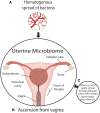Uterine Microbiota: Residents, Tourists, or Invaders?
- PMID: 29552006
- PMCID: PMC5840171
- DOI: 10.3389/fimmu.2018.00208
Uterine Microbiota: Residents, Tourists, or Invaders?
Abstract
Uterine microbiota have been reported under various conditions and populations; however, it is uncertain the level to which these bacteria are residents that maintain homeostasis, tourists that are readily eliminated or invaders that contribute to human disease. This review provides a historical timeline and summarizes the current status of this topic with the aim of promoting research priorities and discussion on this controversial topic. Discrepancies exist in current reports of uterine microbiota and are critically reviewed and examined. Established and putative routes of bacterial seeding of the human uterus and interactions with distal mucosal sites are discussed. Based upon the current literature, we highlight the need for additional robust clinical and translational studies in this area. In addition, we discuss the necessity for investigating host-microbiota interactions and the physiologic and functional impact of these microbiota on the local endometrial microenvironment as these mechanisms may influence poor reproductive, obstetric, and gynecologic health outcomes and sequelae.
Keywords: endometrial cancer; endometrium; gynecologic and reproductive health; host–microbe interactions; infertility; inflammation; microbiome; pathophysiology.
Figures



Comment in
-
Commentary: Uterine Microbiota: Residents, Tourists, or Invaders?Front Immunol. 2018 Aug 24;9:1874. doi: 10.3389/fimmu.2018.01874. eCollection 2018. Front Immunol. 2018. PMID: 30197640 Free PMC article. No abstract available.
References
-
- Carre G, Naud C. Tissier: Recherches sur la flore intestinale des nourrissons (état normal et pathologique). Paris: Dissertation; (1900).
-
- Heinonen PK, Teisala K, Punnonen R, Miettinen A, Lehtinen M, Paavonen J. Anatomic sites of upper genital tract infection. Obstet Gynecol (1985) 66(3):384–90. - PubMed
-
- Hemsell DL, Obregon VL, Heard MC, Nobles BJ. Endometrial bacteria in asymptomatic, nonpregnant women. J Reprod Med (1989) 34(11):872–4. - PubMed
Publication types
MeSH terms
LinkOut - more resources
Full Text Sources
Other Literature Sources

